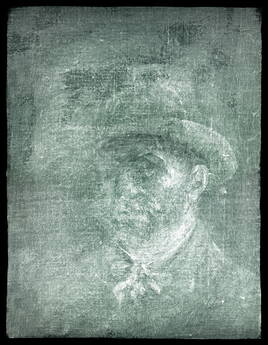by Silvia Lambertucci
And Van Gogh on the back of another Van Gogh. It is the discovery announced by National Galleries of Scotland and which will be at the center of an exhibition “A Taste for Impressionism” scheduled from 30 July to 13 November in the Scottish museum. The self-portrait, she tells very excitedly Lesley Stevenson, Senior Painting conservator of the museum, it was accidentally discovered on the back of “Head of a peasant” (1885) one of the three paintings by Van Gogh owned by the museum, when this, just in anticipation of the exhibition that opens in the next few days, was subjected to a series of radiographic investigations. “Hidden from view for over a century, the self-portrait is covered in layers of glue and cardboard,” they explain from the museum. To save money, the great Dutch artist often reused the canvases. “Except that instead of repainting on previous works he turned the canvas and worked on the reverse,” says a spokesman for the museum. This must have happened in this case too. At the beginning of the 1900s, however, the main painting, Head of a Peasant, was sent to Paris to be exhibited in a large exhibition. And it was then that, perhaps to give more thickness to the canvas, the artisans who had to frame it decided to line it with a layer of cardboard glued on the back, supported by abundant glue. With the result that the painter’s self-portrait, which in all probability had been painted a couple of years after the Peasant’s Head, was lost. Experts from the National Galleries are now evaluating the possibility of unearthing the hidden painting as well. It is clear, however, that it will not be easy: “The process of removing the glue and the cardboard will require delicate conservation work”, they explain from the museum, “We are trying to understand how to do it without damaging the peasant’s head”.
The back of Van Gogh’s painting Head of a Peasant where a self-portrait of the painter was discovered
–
–
At the moment, therefore, we must be satisfied with reading the image hidden inside a lightbox that will be placed in the center of the exhibition. The X-ray image shows a man with a beard and a brimmed hat, a handkerchief tied around his neck that could also be a bow tie. The pose is similar to that of other Van Gogh self-portraits, with the subject’s eye appearing to be staring directly at the viewer, the right side of the face in shadow, the left ear highlighted. “For our museum a discovery of enormous importance”, the senior curator of the Galleries, Frances Fowle, enthuses in a presentation video posted on the museum’s blog.
 –
–
X-ray image shows Van Gogh’s hidden self-portrait on the back of the canvas on which Head of a Peasant Woman is painted
–
–
“Head of a Peasant Woman” was acquired by one of the earliest British Van Gogh collectors, Evelyn Fleming, mother of Ian Fleming, the author of James Bond. In 1951 the painting passed into the hands of the lawyer Alexander Maitland, of Edinburgh, who in 1960 donated it to the National Galleries of Scotland. Once unearthed, the hidden self-portrait will become part of the large group of self-portraits and other works painted by Van Gogh on the back of other canvases. Five can be admired in Amsterdam in the Van Gogh Museum, others are at the Met in New York and at the Wadsworth Atheneum Museum of Art in Hartford in Connecticut just to name a few. Meanwhile, the impact of that scowl, grim, deep, a little ghostly look returned by the X-ray remains. Even with the x-ray filter the emotion comes all.
–


